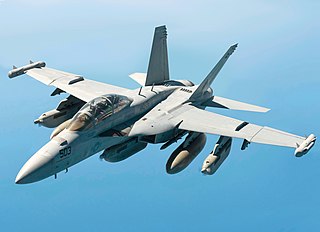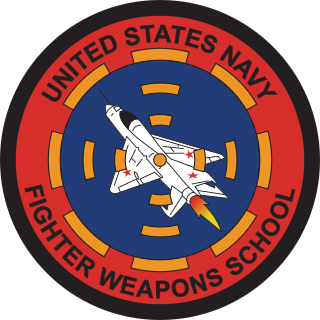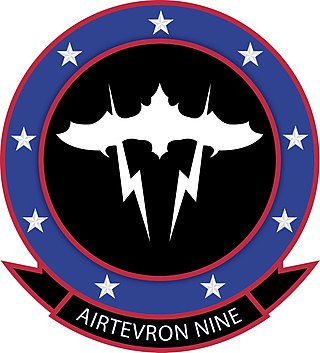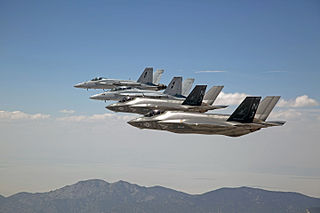
Naval Air Station Fallon or NAS Fallon is the United States Navy's premier air-to-air and air-to-ground training facility. It is located southeast of the city of Fallon, east of Reno in western Nevada. Since 1996, it has been home to the U.S. Navy-Fighter Weapons School (TOPGUN) taking over from the former NAS Miramar, California, and the surrounding area contains 240,000 acres (97,000 ha) of bombing and electronic warfare ranges. It is also home to the Naval Aviation Warfighting Development Center (NAWDC), which includes TOPGUN, the Carrier Airborne Early Warning Weapons School (CAEWWS) and the Navy Rotary Wing Weapons School. Navy SEAL Combat Search and Rescue (CSAR) training also takes place there.

The Boeing EA-18G Growler is an American carrier-based electronic warfare aircraft, a specialized version of the two-seat Boeing F/A-18F Super Hornet. The EA-18G replaced the Northrop Grumman EA-6B Prowlers in service with the United States Navy. The Growler's electronic warfare capability is primarily provided by Northrop Grumman. The EA-18G began production in 2007 and entered operational service with the US Navy in late 2009. Australia has also purchased thirteen EA-18Gs, which entered service with the Royal Australian Air Force in 2017.

The United States Navy Strike Fighter Tactics Instructor program, more popularly known as Top Gun, is a United States Navy training program that teaches air combat maneuvering tactics and techniques to selected naval aviators and naval flight officers, who return to their operating units as surrogate instructors.
A naval flight officer (NFO) is a commissioned officer in the United States Navy or United States Marine Corps who specializes in airborne weapons and sensor systems. NFOs are not pilots (naval aviators), but they may perform many "co-pilot" or "mission specialist" functions, depending on the type of aircraft. Until 1966, their duties were performed by both commissioned officer and senior enlisted naval aviation observers (NAO).

An aggressor squadron or adversary squadron is a squadron that is trained to act as an opposing force in military wargames. Aggressor squadrons use enemy tactics, techniques, and procedures to give a realistic simulation of air combat. Since it is impractical to use actual enemy aircraft and equipment, surrogate aircraft are used to emulate potential adversaries.

Exercise Red Flag is a two-week advanced aerial combat training exercise held several times a year by the United States Air Force. It aims to offer realistic air-combat training for military pilots and other flight crew members from the United States and allied countries.

Joint Terminal Attack Controller (JTAC) is the term used in the United States Armed Forces and some other military forces for a qualified service member who directs the action of military aircraft engaged in close air support and other offensive air operations from a forward position. The term that is used in most other countries, as well as previously in the U.S. and in the relevant NATO standard, is Forward Air Controller. The term became effective in the U.S. on September 3, 2003 with the publishing of Joint Publication (JP) 3-09.3 Close Air Support.

A carrier air wing is an operational naval aviation organization composed of several aircraft squadrons and detachments of various types of fixed-wing and rotary-wing aircraft. Organized, equipped and trained to conduct modern US Navy carrier air operations while embarked aboard aircraft carriers, the various squadrons in an air wing have different but complementary missions, and provide most of the striking power and electronic warfare capabilities of a carrier battle group (CVBG). While the CVBG term is still used by other nations, the CVBG in US parlance is now known as a carrier strike group (CSG).

A Weapon Systems Officer (WSO), nicknamed "Wizzo", is an air flight officer directly involved in all air operations and weapon systems of a military aircraft.
Qualified Weapons Instructor (QWI) (queue-why) is a qualification given to graduates of the British Armed Forces Qualified Weapons Instructor courses. It is the equivalent to the United States Air Force (USAF) Weapons School Course or United States Navy (USN) Naval Aviation Warfighting Development Center warfare schools.

Marine Fighter Attack Training Squadron 101 (VMFAT-101) was a United States Marine Corps F/A-18 Hornet training squadron. The squadron was last based at Marine Corps Air Station Miramar, California and fell under the command of Marine Aircraft Group 11 (MAG-11) and the 3rd Marine Aircraft Wing.

Air Test and Evaluation Squadron Nine is a United States Navy air test and evaluation squadron based at Naval Air Weapons Station China Lake, California. Using the tail code XE, the squadron operates F/A-18E/F Super Hornets and EA-18G Growlers.

Strike Fighter Weapons School Atlantic (SFWSLANT), is a US Navy Atlantic Fleet weapons school based at Naval Air Station Oceana in Virginia Beach, Virginia. The school provides standardized, post-graduate level training for F/A-18 strike fighter tactics, mission planning, strike intelligence and air-launched weapons handling, loading and mission employment to Navy, Marine Corps, and Naval Reserve units. Strike Fighter Weapons School Pacific at Naval Air Station Lemoore in California is the United States Pacific Fleet equivalent.

Draken International, LLC is an American provider of tactical fighter aircraft for contract air services including military and defense industry customers. The firm is based at the Lakeland Linder International Airport in Lakeland, Florida and also has an operating base at Nellis Air Force Base, Nevada.

The Fallon Range Training Complex (FRTC) is a United States Navy military area with four separate training ranges [plus] an integrated air defense system consisting of thirty-seven real or simulated radars throughout the Dixie Valley area of Nevada. The entire FRTC is also instrumented with a Tactical Aircrew Combat Training System (TACTS).
Tactical Air Support, Inc. is an American defense contractor headquartered in Reno, Nevada at Reno-Stead Airport. Some of its employees are former fighter weapons school and operational commanders, instructors, and/or test pilots that specialize in advanced tactical air support. Tactical Air provides consulting and commercial air services to U.S. and allied forces in a manner similar to the Naval Strike and Air Warfare Center (NSAWC) and the USAF Weapons School. TacAir Global, LLC, a wholly owned subsidiary of Tactical Air Support, Inc., focuses on international training. In 2013, Tactical Air began providing F-5 refresher training to the Botswana Defence Force.

Helicopter Maritime Strike Weapons School Pacific (HSMWSP) is a United States Navy helicopter training squadron based at NAS North Island, Coronado, California. HSMWSP provides advanced air combat weapons and tactics training and standardization for ten Pacific Fleet HSM squadrons composed of MH-60R and MQ-8B aircraft.
Dan Pedersen is a retired United States Navy Captain, credited as being the leading force behind the creation of the United States Navy Fighter Weapons School program known as “TOPGUN”.

The United States Navy's Carrier Airborne Early Warning Weapons School, more popularly known as CAEWWS, is an American military unit that develops and teaches E-2D and E-2C Hawkeye tactics, techniques, and procedures (TTP) to selected Naval Aviators and Naval Flight Officers. CAEWWS originated in the early 1980s as the tactics department of VAW-110 on Naval Air Station Miramar, California, but later commissioned on 13 July 1988 as an independent command. Today CAEWWS is incorporated into the Naval Aviation Warfighting Development Center (NAWDC) as the command and control (C2) weapons school along with the Navy Strike Fighter Weapons School (TOPGUN), Airborne Electromagnetic Attack Weapons School (HAVOC), Navy Rotary Wing Weapons School (SEAWOLF), Maritime Intelligence Surveillance Reconnaissance Weapons School (MISR), and STRIKE.

















